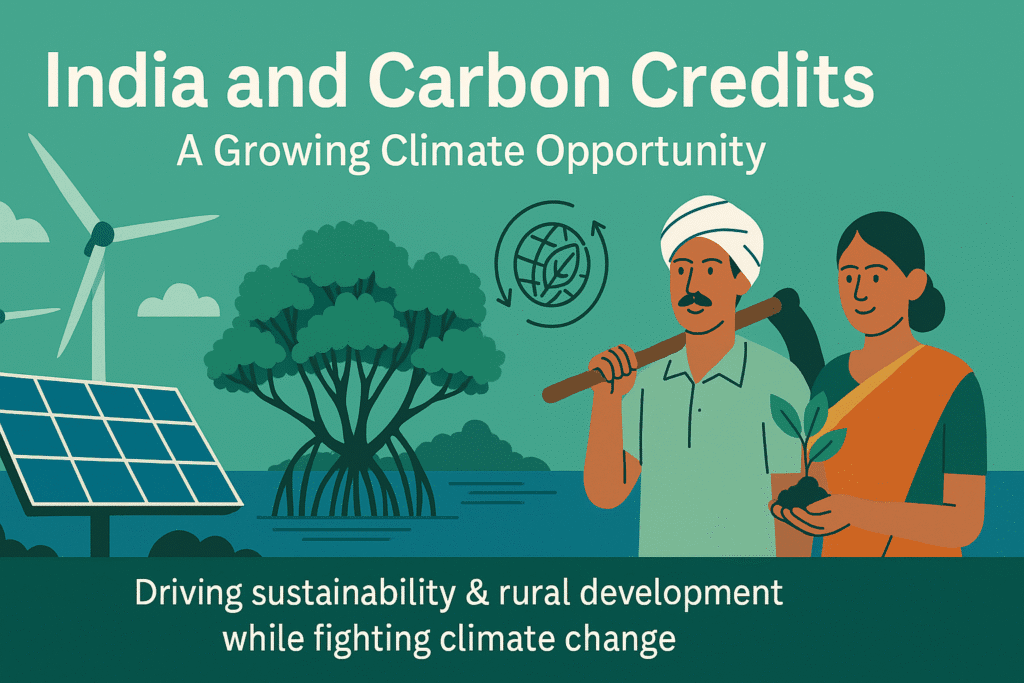India has stepped into the global climate conversation not just as a developing nation trying to balance growth and sustainability, but also as a powerhouse in the carbon credit market. From renewable energy projects to climate-smart agriculture, India is building a strong case for how carbon credits can support both environmental goals and community development.
What Are Carbon Credits?
Carbon credits are certificates that represent a reduction of one metric ton of carbon dioxide emissions. Companies, governments, or individuals can buy these credits to offset their emissions, while the revenue supports projects that actively cut or remove carbon from the atmosphere.
For India, this system offers a dual advantage: helping the planet fight climate change while channeling investment into green growth.
India’s Role in Carbon Credit Generation
India is among the world’s largest suppliers of carbon credits. Thousands of projects have been registered in areas like:
- Renewable energy – wind, solar, hydropower, biomass
- Forestry and agroforestry – reforestation, mangrove restoration, and tree planting
- Sustainable practices – improved cookstoves, biogas, biochar, and climate-smart farming
With its vast agricultural base and growing clean energy sector, experts estimate India could generate 300–400 million credits every year for domestic and global buyers.
The Policy Push: India’s Carbon Credit Trading Scheme
In 2023, India launched the Carbon Credit Trading Scheme (CCTS), a major step toward creating a domestic carbon market. This scheme will eventually merge with existing frameworks like:
- Renewable Energy Certificates (RECs)
- The Perform, Achieve, and Trade (PAT) scheme
- Energy efficiency initiatives
The goal is simple: build a transparent carbon market that supports India’s net-zero emissions target by 2070.
Why This Matters Globally
Indian carbon credits are already traded in voluntary carbon markets (VCMs), where global corporations buy them to offset emissions. With the Paris Agreement’s Article 6 paving the way for cross-border trading, India’s carbon market is set to become even more globally integrated.
Emerging areas such as biochar, carbon capture technologies, and nature-based solutions like mangroves are particularly attractive for international buyers.
Challenges Ahead
While the opportunities are massive, a few roadblocks remain:
- Ensuring transparency and accountability in monitoring carbon reductions
- Avoiding greenwashing and maintaining integrity in credit generation
- Including small farmers and rural communities fairly in projects
- Addressing price volatility, which can discourage long-term investments
Opportunities for India
On the bright side, India’s carbon credit journey is also a story of opportunity:
- For farmers: practices like agroforestry, direct seeded rice, and biochar not only generate credits but also improve soil, yield, and resilience.
- For businesses: companies can meet sustainability targets and improve their ESG ratings while supporting community-driven projects.
- For innovators: blockchain-based registries, satellite monitoring, and AI-driven verification are opening new avenues in the carbon credit space.
The Road Ahead
India’s carbon credit ecosystem is at an exciting turning point. With the right policies, technology, and grassroots participation, it can emerge as a global leader in supplying high-integrity carbon credits. More importantly, this market can empower local communities, drive rural development, and help India march steadily toward its climate goals.
🌱 In essence, carbon credits are more than just numbers on a balance sheet for India—they represent a bridge between sustainable development and global climate action.

